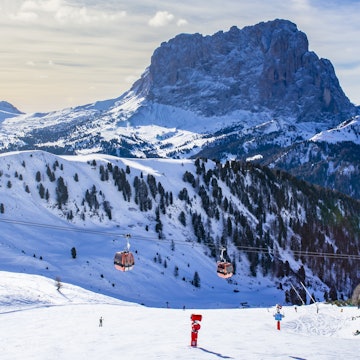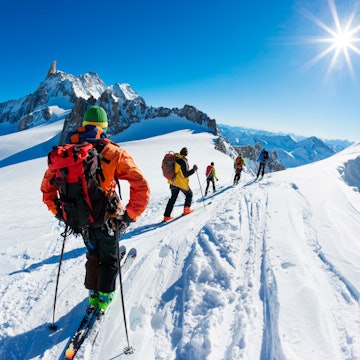

There's a good reason Utah is spoken about in reverent tones by skiers. Shutterstock
It’s a big world out there. It’s surely snowing somewhere no matter the time of year.
Indeed, thanks to the alternating winters in the northern and southern hemispheres, skiers and snowboarders are able to hit the slopes at any time. If you prefer fresh powder to sand and surf – and you’re willing to travel from Scandinavia to Australia and beyond – here’s a list for chasing winter all year long.
January: Salt Lake City, USA
Skiers and boarders discuss Utah’s voluminous powder snow in rapt tones. State license plates have bragged about “the greatest snow on Earth” since 1985 – and the hype is well founded. Few North American winter-sports hubs enjoy as much snowfall – around 550 inches per season – as the four main resorts clustered around Salt Lake City.
Cold, dry weather gives the snow a buoyant quality, ideal for off-piste antics (not to mention very soft landings). Skiers will revel in the breathtaking views around Alta, while the top pick for snowboarders (who are not allowed at Alta) is vast Snowbird. Meanwhile, wide-open Solitude has a web of challenging black (advanced) runs that will keep even the most experienced skiers engaged.

February: Hokkaidō, Japan
In Hokkaidō, cathedrals of ice and snowy beasts aren’t hallucinations induced by too much sake. Each February, sub-zero sculptures are unveiled at Sapporo Snow Festival. On the mountains, nature crafts its own surreal display: juhyō (snow monsters), formed when trees are blasted with snow and ice, are at their most impressive in February.
Ski past battalions of juhyō at crowd-pleasing resort Sapporo Kokusai, one hour’s drive west of Sapporo city – or (if you’re a pro), thunder across legendary backcountry. Still yearning to face-plant in fluffy snow? Continue southwest to powder capital, Niseko.

March: Whistler, Canada
When the dreaded spring melt sets in at resorts across Europe and North America, skiers in British Columbia continue merrily on the mountains. The 32-sq-km (12 sq-miles) Whistler-Blackcomb groans under 12 meters (39ft) of snowfall each year, which means it’s still at its prime in March.
More than 200 well-groomed pistes wend across the two mountains, with a mile of skiable vertical that dwarfs other North American resorts. To leave fresh tracks in pristine backcountry snow, grab some avalanche gear and a local guide to explore the lonely snowfields of Garibaldi Provincial Park.
April: Obertauern, Austria
Think quaint chalets and pillowy snow are for wimps? Winter travelers who crave wild, windswept terrain should head to Obertauern, 90km (56 miles) south of Salzburg, Austria. From its dizziest heights – around 2350m (7701ft) – you can survey the towering Austrian Alps as you zoom across 100km (62 miles) of pistes; just be sure to bring a balaclava to fend off the biting winds. Obertauern was one of the filming locations for Help!, should that inspire you to belt out Beatles tunes from the bubble lift.

May: Riksgränsen, Sweden
Lying 200km (124 miles) above the Arctic Circle is Sweden’s northernmost winter resort, Riksgränsen. The ski area’s vertical drop, at under 400m (1312ft), can’t compete with other European resorts, but expansive off-piste trails, winding among cloud-like snowdrifts and frost-rimmed forests, more than compensate.
Mix it up by snowshoe trekking around Lake Vassijaure or commanding a fleet of sled dogs, then watch professional shredders in Scandinavia’s Big Mountain Championships. At the end of May, when the sun barely touches the horizon, you’ll need steely willpower to hang up your skis and (try to) sleep.
June: Cardrona, New Zealand
When Europeans and North Americans mournfully shelve their gear for the season, New Zealanders are busy waxing their skis. Cardrona, where the winter season kicks off in mid-June, is nestled prettily in the Southern Alps. Half of its 345-hectare (852-acre) pisted area suits novice and intermediate levels, while seasoned snowheads can somersault around the southern hemisphere’s biggest half-pipe and park facilities. Just 20km (12.4 miles) south, Cardrona Distillery is the perfect place to stock up on après-ski refreshments.

July: Las Leñas, Argentina
Luxury is best served with a sprinkling of powder snow. Premium ski resort Las Leñas gleams out from the Argentine portion of the mighty Andes mountain range. Its slopes climb from 2200m (7218ft) to a vertiginous 3400m (11,155ft), which means you should start slowly to avoid altitude sickness. (There’s no more enjoyable way to adjust than in a lavish spa hotel; Hotel Virgo is the fanciest.) Best of all, you’re in Mendoza wine country, where après-ski involves swishing an inky malbec around your glass while eyeing a menu of succulent steaks.
August: Perisher Valley, Australia
Dispel images of foaming surf and sail-shaped opera houses: New South Wales is home to a small but hardy community of skiers, who make an annual pilgrimage to Perisher, the southern hemisphere’s biggest ski resort. A valley carved among Australia’s Snowy Mountains, Perisher has an altitude (and more than 200 snowmaking machines) to ensure it’s blanketed in the white stuff each August. Snowboard or ski across its 12 sq km (2965 acres), or clamp on some snowshoes to roam the scenic Rock Creek track.

September: Corralco, Chile
Compared to busier ski hubs closer to Santiago, this friendly resort on the southern slopes of Chile’s 2865m-high (9400ft) Lonquimay is blissfully low-key. After the stormy first half of the ski season, August and September in Corralco bring bluer skies and fewer crowds. Its 18 sq km (4450 acres) of snow-lashed terrain is superb for newbie or intermediate skiers and boarders. Only 10km (6 miles) southwest of the resort, the natural hot springs in Malalcahuello beckon to sore limbs.
October: Whakapapa, New Zealand
Fancy snowboarding on an active volcano? Of course you do. Splayed across the northwestern slopes of Mt Ruapehu, Whakapapa is simply superb for groups of mixed ability. There’s a huge area dedicated to learners called Happy Valley, as well as 24 steep “Black Magic” runs for advanced boarders, skiing pros or show-offs with robust travel insurance. Together with sister resort Tūroa, Whakapapa forms New Zealand’s biggest ski area, and boasts the country’s loftiest chairlift, the High Noon Express. Just don’t look down.

November: Ruka, Finland
As southern hemisphere resorts shutter their chalets, northern ones wait anxiously for snowfall: November is the cruelest month for skiers. Luckily, far northern Ruka, a frosty fell in eastern Finland, has 200 days of snow per year, plus snowmaking machines to keep the hills downy and white. Most thrilling are Ruka’s 500km (311 miles) of cross-country skiing and snowmobile trails, threading among forests and frozen lakes.
December: Val Thorens, France
Finish out the year with a flurry of snow in Val Thorens, Europe’s highest ski village. Posing from a 2300m (7546ft) perch in the French Alps, this purpose-built winter-sports retreat accesses the largest linked ski area on the planet, Les Trois Vallées (Three Valleys). Glide down 600km (373 miles) of slopes, schuss more than 300 cross-country trails, and dip into villages like pretty Méribel and low-key Le Praz for hot chocolate. As steam curls from your chocolat chaud (hot chocolate) and you look out on a panorama of mountains piercing the clouds, you might find yourself dreaming ahead to another full year of wintry adventures.














